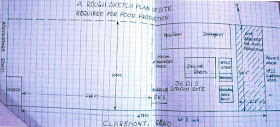During research for a book on West Ham Fire Brigade, it
emerged that a temporary WW2 fire station had been constructed on Claremont
Road, Forest Gate. The book's author and E7-NowAndThen stalwart, Peter
Williams, writes:
The station was designated 36 D15 (station D15 of fire force
36), National Fire Service - see later. This is shown on the plan below -
The diagram clearly locates it between the Methodist church,
Woodgrange Road, destroyed in a bomb blast on 17 April 1941, (see photo, below)
and No. 23 Claremont Road which survives - as the first house on the road,
after the Kebbell Terrace flats. The bomb was clearly a large one, which not only
destroyed the church, but also killed 5 people, living at numbers 3, 5 and 6
Claremont Road - thus creating a substantial bomb site.
 |
| Above and below, Woodgrange Methodist church after 17 April 1941 bomb |
It seems there was a originally a plan to put an allotment next to the station and 23, no doubt as part of the huge ‘Dig for Victory’ campaign to boost wartime food production (see poster used during the era).
One can see on the plan the (fire) engine room, a separate dormitory, and office /store and a watch room, where telephone calls were received about incidents and a fireman or firewoman was on duty or watch.
These buildings were temporary and could have been quite flimsy huts made of corrugated iron, or they may have been brick built. EWS on the plan means ‘emergency water supply’ and that would have been some kind of tank, possibly in the cellars of the bombed out buildings.
There were many of these kinds of temporary fire stations in
huts, or evacuated schools, or empty garages. After the Blitz on London, from
September 1940, preparations had to be made for further mass aerial attacks on
cities. Local fire services were struggling to cope so in spring 1941 the fire service was nationalised by the
wartime coalition government, on a promise that it would return to local
authority control post war.
Many of these temporary stations were commissioned by the
National Fire Service (NFS), or, prior to that being formed, the Auxiliary Fire
Service (AFS). The AFS was created in the late 1930's by all local authorities.
Volunteers joined up and were trained by professional fire-fighters. They had
little to do in 1939-40 (the so called phoney war) and many left the service.
The AFS was issued with all kinds of rather improvised
equipment – rather like Dad’s Army – and one can see in the photo below that
taxis were commandeered to tow what were known as trailer pumps.
These were more effective that they might seem, and many
serious wartime fires in the West Ham blitz were fought by multiple trailer
pumps towed by a wide variety of cars and lorries commandeered by the government.
Sadly no known photograph of Claremont Road fire station
survives, but it would have looked like
this.
 |
| A similar scene Brockley, South London, note the hut like temporary fire station to the rear. Source, here |
To get a very good view of this kind of fire station, see
the wonderful wartime documentary, ‘Fires were started’ by Humphrey Jennings. See
here:
Cyril Demarne, a West Ham fire officer, assisted the film director,
as technical adviser, during his NFS days in Whitechapel 1942-1943. Cyril later
became chief of the post war West Ham Fire Brigade.
 |
| From Fires were started. |
Below is a photograph of the former station's location
today, on the entrance land between 23 Claremont Road and Kebbell Terrace.
The flats, themselves, were built post war by the council to
occupy the space between the church and 23 Claremont Road. Below is an
architect's model, dated July 1954, for the area discussed in this article.
Footnotes
1. Source for plan: NFS/AFS file number/box 7984 titled ‘fire
service’ kept in the basement archive, Newham council archives, Stratford
library.





No comments:
Post a Comment
We welcome comments to all the items featured on this site. However, we reserve the right to omit offensive comments, and edit the length of comments, for reasons of space.